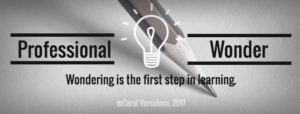The Reading Teacher – Invest in Teachers

“Better than a thousand days of diligent study is one day with a great teacher.” This Japanese proverb supports what Richard Allington’s research explains: It’s teachers who make a difference in children’s learning. Yet, schools invest mega-dollars in programs—basal reading programs. computer reading programs with scripted guides that tell teachers what to say and how students should reply. The notion of a quick fix to transform students into proficient and advanced readers maintains its allure to many school districts around the country.
We need to let go of the search for the magic bullet that quickly turns every student into a successful and motivated learner. The solution resides in every school: teachers. Invest in teachers and make ongoing professional study at the building level the core strategy for supporting all students. This is not the quick fix school districts yearn for; this is an investment that works.
Investing in teachers also means giving them the materials needed to reach students at diverse instructional reading levels: class libraries with 1,000 to 2,000 books for independent reading and book rooms that have five to six copies of the finest literature relating to the topics in units of studies across the curriculum—all at instructional reading levels that represent the school’s student population. Take careful note: having the best books available for students won’t matter unless teachers receive the training that enables them to use resources to meet students’ needs.
Pre-service Training
While attending college, it’s crucial to learn the way you will be teaching your students. Instead of lecturing, teachers collaborate, experience project based learning, genius hour, guided reading, differentiating instruction, and explore how to use technology to enhance learning. In addition, college education curriculum should prepare teachers to manage a classroom of diverse learners as well as how to actively involve students in their learning. For you to work in a rapidly changing world, professional study needs to continue in schools where you teach.
Ongoing Professional Learning
One-shot workshops don’t have lasting power, even when they are from outstanding educators. They can inspire teachers and administrators to reflect on change, but without follow-up, they tend to fizzle and soon are forgotten. So, to make the most of an inspirational, active learning workshop, it’s important for administrators and literacy coaches to keep the conversation going and provide the support needed to change and adjust instruction. It also means that administrators need to attend workshops that you attend. The suggestions that follow maintain a focus on PD.
Faculty and Team Meetings: You and colleagues learn using professional materials in ways their students will learn. You collaborate, have meaningful conversations, raise questions, share ways you could integrate technology, write about your reading and ask: How can I use the information in this article to support my students?
Google Docs: Administrators, reading specialists, and teachers can take turns posting a professional article once each month on Google Docs. This is an excellent way to enlarge your theory of how children learn, best practices, and twenty-first century skills: collaboration, communication, creativity, critical thinking, and technology. You and other staff members respond on Google Docs with a comment, question, or connection to classroom practices. Observing Colleagues: By observing a colleague, you can learn about class management, motivation, engagement, and how experiences foster creativity and collaboration. Finding the time to do this is always an issue. I suggest that school administrators step up and cover a class to make this happen. It’s important to follow up an observation of a colleague teaching with a conversation to offer feedback, pose questions, and clarify understandings.
Teachers as Readers Groups: When the principal suggests organizing groups that read and discuss a professional book the group chooses, and the school purchases the books for the group, it tells teachers, “The principal and this school community value professional learning.” Best, if principals invite you to volunteer to participate, as you will have to commit extra time. If the principal organizes groups twice a year, teachers will eventually join one–and the principal should also join one.
Take Advantage of Twitter: Encourage the entire school staff to open a twitter account and become active on this social network platform. Twitter offers interactions with educators and writers around the country and world. Learning occurs when you explore articles suggested in tweets, comment on these, and reflect on thought-provoking quotes that occur daily. Ask a question about teaching on twitter, and you’ll receive several thoughtful replies.
Partnerships: Encourage teachers to form a partnership with a colleague they trust. Teacher partnerships hold myriad possibilities: discuss the kind of feedback to offer a student, learn more about project-based learning and genius hour, share ideas and uses of technology, professional articles, read aloud texts. There are no limits on what partners can share, learn together, and discuss.
Closing Thoughts
Nothing can replace you, the teacher, in the classroom. That’s why ongoing professional development at the building level is so important. Unlike computers and robots, when you possess deep knowledge about how children learn, you can process students’ actions, words, and written work and provide feedback that moves each child forward. Moreover, you have a heart and emotional center that enables you to build students’ self-efficacy, self-confidence, motivation, and engagement in learning because students feel your respect and trust, your hopes and goals, as they experience your investment in their progress.
Learn more from a great book by Laura, Read-Talk-Write

![]()














